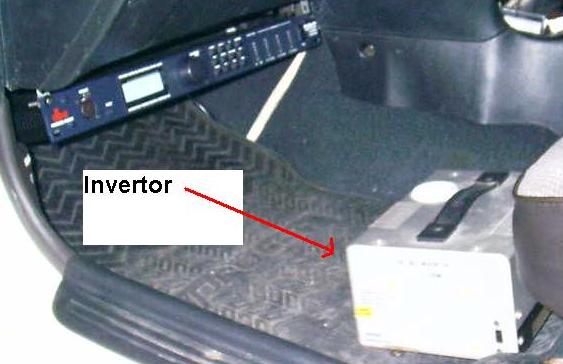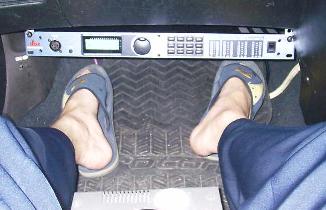

No Limits - PA System's DSP in Car
circa 2003
Here a Professional Audio DSP dbx DriveRack PA is installed in a car, which still uses ~220v AC so we use a DC 12v to AC 220v inverter as power supply. The specification to the equipment may be found here: - http://www.driverack.com/PAspecs.htm
This was chosen because it had stereo inputs and 3 pairs of stereo outputs. All the necessary tools are included like parametric EQ, cross-overs, delay, 28 band EQ etc. It didn't cost toooooo much. Around RM 2.6k the deal is good considering the amount of work it could do especially when utilizing saved memory setting to make quick changes to listen to the difference.
The 1st pair of stereo output is set to high-pass-filter (cross-over) using 24dB/oct Linkwitz Riley family and used to signal the tweeter's amplifier. The cross-over point is determined from the tweeter's investigation to find out the lowest frequency which it could produce. i.e. if it plays 1kHz 10dB less than 1.6kHz when using the same power, then there is no point to set to 1kHz.
The 2nd pair of stereo output is set to band-pass-filter (cross-over), which consists of a high-pass around 100Hz and low-pass set to where the tweeter start to take over.
Finally the 3rd pair of stereo output is set to band-pass again to limit the woofer's lowest frequency excursion, so not to waste amplifier's power below 40Hz or so. By saving these voltages and current, the amplifier's effective damping is increased and could control the woofer's excursion much better. The bass note would be solid and full of impact and not blaaa blaaa blaaaaa where it struggles to play everything without control.
The delay was found to be ...... fakey in sound ...... so I don't like it. When delayed too long ....... over 30ms = 30 feet starts to sound like a cave ..... especially around 100ms.
The EQ was found to be ........... "phase" disturbing - when used too much. And how much is too much? i.e. more than 3dB boost or cut and when two EQ frequency is close to each other. i.e. say 1kHz using 0.5Q and another at 1.4kHz using 0.7Q. They overlap and disturb each other both in signal and in phase. So terrible.
At the end, the EQ is nearly not used. Except this DSP was found be like rolling off sooner than expected starting around 17kHz, hence a shelving EQ was used to bring the signal output back to flat frequency response. This was found out from listening test and then confirmed by measurement by LMS.
The complete system was a success, giving very high quality sound but the secret is not in this DSP, but in the selection of tweeter most importantly and mid-range. Without a good driver, no matter how good the electronics will be, is going to be a waste.
The tweeter had very smooth frequency response, not flat, but really smooth transition without peaks and dips. This is the most important key to a good driver. The transition proofs that the transfer of mechanical energy to acoustical energy is ....... smooth / fine and not fighting........ The mid is however nearly flat frequency response from around 100Hz to 1khz. Dam nice :) All measurements are near-field 10mm.
and finally some install pictures: -


ACOUSTICS SECTION AUDIO SECTION CAR SECTION
HOME - Technical Website for Acoustics, Audio and Car